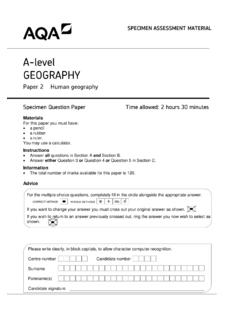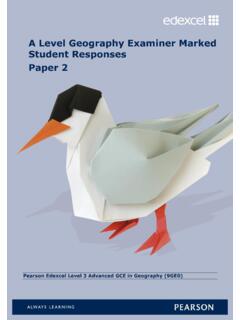Transcription of A-level GEOGRAPHY PAPER 2 - AQA
1 SPECIMEN ASSESSMENT MATERIAL. A-level GEOGRAPHY . PAPER 2 HUMAN GEOGRAPHY . Mark scheme Sample assessment material MARK SCHEME A-level GEOGRAHY PAPER 1 SAM. Mark schemes are prepared by the Lead Assessment Writer and considered, together with the relevant questions, by a panel of subject teachers. This mark scheme includes any amendments made at the standardisation events which all associates participate in and is the scheme which was used by them in this examination. The standardisation process ensures that the mark scheme covers the students'. responses to questions and that every associate understands and applies it in the same correct way. As preparation for standardisation each associate analyses a number of students' scripts. Alternative answers not already covered by the mark scheme are discussed and legislated for.
2 If, after the standardisation process, associates encounter unusual answers which have not been raised they are required to refer these to the Lead Assessment Writer. It must be stressed that a mark scheme is a working document, in many cases further developed and expanded on the basis of students' reactions to a particular PAPER . Assumptions about future mark schemes on the basis of one year's document should be avoided; whilst the guiding principles of assessment remain constant, details will change, depending on the content of a particular examination PAPER . Further copies of this mark scheme are available from 2. MARK SCHEME A-level GEOGRAPHY PAPER 1 SAM. Level of response marking instructions Level of response mark schemes are broken down into levels, each of which has a descriptor.
3 The descriptor for the level shows the average performance for the level. There are marks in each level. Before you apply the mark scheme to a student's answer read through the answer and annotate it (as instructed) to show the qualities that are being looked for. You can then apply the mark scheme. Step 1 Determine a level Start at the lowest level of the mark scheme and use it as a ladder to see whether the answer meets the descriptor for that level. The descriptor for the level indicates the different qualities that might be seen in the student's answer for that level. If it meets the lowest level then go to the next one and decide if it meets this level, and so on, until you have a match between the level descriptor and the answer. With practice and familiarity you will find that for better answers you will be able to quickly skip through the lower levels of the mark scheme.
4 When assigning a level you should look at the overall quality of the answer and not look to pick holes in small and specific parts of the answer where the student has not performed quite as well as the rest. If the answer covers different aspects of different levels of the mark scheme you should use a best fit approach for defining the level and then use the variability of the response to help decide the mark within the level, ie if the response is predominantly level 3 with a small amount of level 4 material it would be placed in level 3 but be awarded a mark near the top of the level because of the level 4 content. Step 2 Determine a mark Once you have assigned a level you need to decide on the mark. The descriptors on how to allocate marks can help with this.
5 The exemplar materials used during standardisation will help. There will be an answer in the standardising materials which will correspond with each level of the mark scheme. This answer will have been awarded a mark by the Lead Examiner. You can compare the student's answer with the example to determine if it is the same standard, better or worse than the example. You can then use this to allocate a mark for the answer based on the Lead Examiner's mark on the example. You may well need to read back through the answer as you apply the mark scheme to clarify points and assure yourself that the level and the mark are appropriate. Indicative content in the mark scheme is provided as a guide for examiners. It is not intended to be exhaustive and you must credit other valid points.
6 Students do not have to cover all of the points mentioned in the Indicative content to reach the highest level of the mark scheme. An answer which contains nothing of relevance to the question must be awarded no marks. 3. MARK SCHEME A-level GEOGRAHY PAPER 1 SAM. Qu Part Marking guidance Total marks Section A. 01 1 Explain how one transnational corporation (TNC) has contributed 4. to the globalisation of the world's economy. AO1 = 4. Mark scheme Award one mark each for points of knowledge or understanding. Allow extra marks for developed points (d). Notes for answers Allow credit for specific knowledge of how the chosen TNC has contributed to increased flows of goods, capital, labour and /or technology and ideas Nike has become one of the world's largest suppliers of sports equipment (1), employing over 44 000 workers in over 50 countries (1) (d).
7 Manufacturing helps the social and economic development of these countries through the transfer of skills, technology and the rise in wages (1). The company's headquarters and much research takes place in Oregon in the USA (1) but its products are manufactured in poorer countries like Indonesia and Vietnam, where labour costs are cheaper (1) (d). Components for sports goods are sourced from various different countries around the world (1), including rubber for its trainers from Malaysia and Indonesia and cotton from Turkey and India(1) (d). From its global operations Nike's annual turnover continues to rise, with profits reaching $14 billion in 2015 (1). The company has increased its global market and reputation by sponsoring and promoting international sports events and sports stars (1).
8 01 2 Using Figures 1, 2, and 3, analyse characteristics of the climate of 6. Antarctica. AO3 = 6. AO3 Analysis of climatic statistics to examine variations in the features of climate in Antarctica. Mark scheme Level 2 (4 6 marks). 4. MARK SCHEME A-level GEOGRAPHY PAPER 1 SAM. AO3 Clear analysis of the quantitative evidence provided, which makes appropriate use of data. Clear connection(s) between different aspects of the data and evidence. Level 1 (1 3 marks). AO3 Basic analysis of the quantitative evidence provided which makes limited use of data. Basic or limited connections between different aspects of the data. Notes for answers This question requires analysis of climatic data for 3 stations in Antarctica, illustrating variations in temperature and precipitation across the continent.
9 AO3. The data illustrates conditions of extreme cold throughout the year, with no recorded monthly temperatures above freezing (Figure 1). The lowest monthly temperatures at all three stations occur more or less continuously through the Antarctic winter of total darkness in the months April September. After this, there is a 4-month period where the temperature rises to a peak in January and then drops rapidly again (Figures1 and 2). Average annual temperatures vary between the three locations: 14 C at McMurdo, 40 C at Amunden Scott and 55 C at Vostok. Similarly, there is much variation in annual temperature range: 23 C at McMurdo, 32 C at Amunden Scott and 36 C at Vostok. (Figure 1). This shows that a coastal location is much less extreme than places further inland (Figure 1).
10 Indeed, the lowest temperatures are recorded at a point that is furthest from the sea, not at the geographical pole. (Figure 1). Temperatures show a link with altitude, with higher temperatures recorded at McMurdo, which is close to sea level, in comparison with Vostok, which has the lowest temperatures at around 3500 metres altitude. Temperatures are generally 30 40 degrees Celsius higher on the coast than at the centre of Antarctica. (Figure 1). Precipitation is likely to be in the form of snow due to perpetually low temperatures and is generally very low, varying between 7 and 200 mm at the 3 weather recording stations (Figure 2). The coastal station records the highest precipitation, but in the interior, precipitation drops almost to zero. The South Pole receives only 7 mm per year (Figure 2), despite the high altitude of almost 3000 metres.












